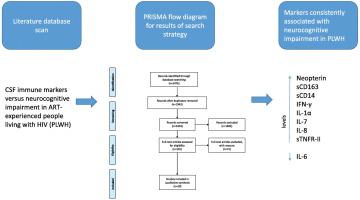Journal of Neuroimmunology ( IF 2.9 ) Pub Date : 2021-06-30 , DOI: 10.1016/j.jneuroim.2021.577649 Monray E Williams 1 , Dan J Stein 2 , John A Joska 3 , Petrus J W Naudé 4

|
HIV-1 is responsible for the development of a spectrum of cognitive impairments known as HIV-associated neurocognitive disorder (HAND). In the era of antiretroviral therapy (ART), HAND remains prevalent in people living with HIV (PLWH), despite low or undetectable viral loads. Persistent neuroinflammation likely plays an important role in the contributing biological mechanisms. Multiple cerebrospinal fluid (CSF) immune markers have been studied but it is unclear which markers most consistently correlate with neurocognitive impairment. We therefore conducted a systematic review of studies of the association of CSF immune markers with neurocognitive performance in ART-experienced PLWH. We aimed to synthesize the published data to determine consistent findings and to indicate the most noteworthy CSF markers of HAND. Twenty-nine studies were included, with 20 cross-sectional studies and 9 longitudinal studies. From the group of markers most often assayed, specific monocyte activation (higher levels of Neopterin, sCD163, sCD14) and neuroinflammatory markers (higher levels of IFN-γ, IL-1α, IL-7, IL-8, sTNFR-II and lower levels of IL-6) showed a consistent direction in association with HIV-associated neurocognitive impairment. Furthermore, significant differences exist in CSF immune markers between HIV-positive people with and without neurocognitive impairment, regardless of viral load and nadir/current CD4+ count. These markers may be useful in furthering our understanding of the neuropathology, diagnosis and prognosis of HAND. Studies using prospective designs (i.e. pre- and post-interventions), “multi-modal” methods (e.g. imaging, inflammation and neurocognitive evaluations) and utilizing a combination of the markers most commonly associated with HAND may help delineate the mechanisms of HAND.
中文翻译:

脑脊液免疫标志物和 HIV 相关的神经认知障碍:系统评价
HIV-1 导致一系列认知障碍的发展,称为 HIV 相关神经认知障碍 (HAND)。在抗逆转录病毒治疗 (ART) 时代,尽管病毒载量低或检测不到,但 HAND 仍然在 HIV 感染者 (PLWH) 中普遍存在。持续性神经炎症可能在促成生物学机制中发挥重要作用。已经研究了多种脑脊液 (CSF) 免疫标志物,但尚不清楚哪些标志物与神经认知障碍最一致。因此,我们对 CSF 免疫标志物与接受过 ART 的 PLWH 的神经认知表现的关联的研究进行了系统评价。我们旨在综合已发表的数据以确定一致的发现并指出 HAND 最值得注意的 CSF 标志物。纳入了 29 项研究,20 项横断面研究和 9 项纵向研究。在最常检测的一组标志物中,特异性单核细胞活化(新蝶呤、sCD163、sCD14 水平较高)和神经炎症标志物(IFN-γ、IL-1α、IL-7、IL-8、sTNFR-II 水平较高和较低IL-6 水平)显示出与 HIV 相关神经认知障碍相关的一致方向。此外,无论病毒载量和最低点/当前 CD4 sTNFR-II 和较低水平的 IL-6) 显示出与 HIV 相关神经认知障碍相关的一致方向。此外,无论病毒载量和最低点/当前 CD4 sTNFR-II 和较低水平的 IL-6) 显示出与 HIV 相关神经认知障碍相关的一致方向。此外,无论病毒载量和最低点/当前 CD4+计数。这些标志物可能有助于我们进一步了解 HAND 的神经病理学、诊断和预后。使用前瞻性设计(即干预前和干预后)、“多模式”方法(例如成像、炎症和神经认知评估)和使用最常与 HAND 相关的标志物组合的研究可能有助于描绘 HAND 的机制。










































 京公网安备 11010802027423号
京公网安备 11010802027423号